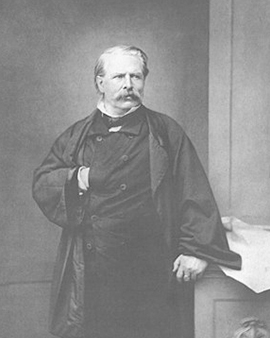Moritz Ludwig von Schwind, born on January 21, 1804 in Vienna and died on February 8, 1871 in Niederpöcking, Kingdom of Bavaria, was an outstanding figure of the late Romantic period as an Austrian painter and draftsman. His artistic output and unique interpretation of Romantic aesthetics made him an important representative of his time. Born to Franz Edler von Schwind and Franziska von Holzmeister, Moritz grew up in a wealthy family that provided him with a good education. His father, who came from Bohemia and worked for the Privy Court Chancellery as court secretary, was knighted a knight of the realm in 1792. He attended the Schottengymnasium in Vienna and then began studying at the university. Despite family expectations that he would follow in his father's footsteps and pursue a civil service career, Moritz followed his passion for art. In 1821, he began his studies at the Academy of Fine Arts in Vienna under Johann Peter Krafft and Ludwig Ferdinand Schnorr von Carolsfeld.
In 1828, he was drawn from Vienna to Munich, a city that fascinated him with the diversity and richness of its art scene. Here he was able to develop his artistic skills and shape his own artistic identity. Thanks to the mediation of Peter von Cornelius, he was commissioned to paint the library room of the Bavarian queen with scenes from Ludwig Tieck's poetry. After a trip to Italy in 1835, he created designs for the Munich Residence and Hohenschwangau Castle. His work attracted attention and led to commissions from Saxony and Baden, cementing his reputation as an artist. From 1840 to 1844 Moritz von Schwind lived and worked in Karlsruhe. Here he met his future wife Luise Sachs, the daughter of a major. During this time he created important works such as eight round medallions for the meeting hall of the Karlsruhe Ständehaus and frescoes for the Staatliche Kunsthalle. After moving to Frankfurt from 1844 to 1847, he taught at the Städelschule and had the Moritz-von-Schwind-Haus, a villa of his own design, built there.
His further stations led him back to Munich, where he became a professor at the Academy of Fine Arts in 1847. A significant commission was the painting of the restored Wartburg near Eisenach on behalf of the Weimar hereditary grand duke. One of his most famous works from this period is the "Singer's War". In 1855 he and his brothers August and Franz were knighted. In addition to his remarkable professional achievements, Moritz von Schwind also led a full private life. With his wife Luise Sachs, he had a son and five daughters, three of whom survived. He was also active in artistic and literary circles and maintained friendships with such notables as Franz Schubert, Franz von Schober and Leopold Kupelwieser.
His contribution to art was enormous and left a deep impression in the history of romantic painting. His characteristic style, characterized by a poetic and popular depiction of themes from German sagas and fairy tales, has produced many works of art that can still be seen in museums and galleries around the world. In addition, many of his works have also been produced as art prints, which has helped bring his artistic vision and aesthetic to a wider audience. Although his artistic expression was nationally limited, like that of Carl Spitzweg, his influence on German late Romanticism remains undisputed. His achievements were recognized by the naming of various streets and squares after him in Frankfurt am Main, Hanover, and Munich. Street names in Vienna and Niederpöcking also commemorate the great painter and draftsman. His memory lives on in the hearts of many art lovers and in the art prints of his works that delight people worldwide. Moritz von Schwind remains an inspiring figure in the history of Romantic painting.
×





_drawing_by_Moritz_von_Schwind_of_18_-_(MeisterDrucke-933544).jpg)
_drawing_by_Moritz_von_Schwind_of_18_-_(MeisterDrucke-933544).jpg)
.jpg)
.jpg)
.jpg)
.jpg)
.jpg)
.jpg)
.jpg)
.jpg)
.jpg)
.jpg)
.jpg)
.jpg)
.jpg)
.jpg)
.jpg)
.jpg)
 - (MeisterDrucke-102109).jpg)
 - (MeisterDrucke-102109).jpg)
.jpg)
.jpg)
_1850_-_(MeisterDrucke-803716).jpg)
_1850_-_(MeisterDrucke-803716).jpg)
.jpg)
.jpg)
.jpg)
.jpg)
.jpg)
.jpg)
_-_(MeisterDrucke-1019078).jpg)
_-_(MeisterDrucke-1019078).jpg)
.jpg)
.jpg)
_-_(MeisterDrucke-35534).jpg)
_-_(MeisterDrucke-35534).jpg)
.jpg)
.jpg)
_-_(MeisterDrucke-996265).jpg)
_-_(MeisterDrucke-996265).jpg)
.jpg)
.jpg)
.jpg)
.jpg)
.jpg)
.jpg)
.jpg)
.jpg)
.jpg)
.jpg)
.jpg)
.jpg)
_-_(MeisterDrucke-36418).jpg)
_-_(MeisterDrucke-36418).jpg)
_-_(MeisterDrucke-989711).jpg)
_-_(MeisterDrucke-989711).jpg)
.jpg)
.jpg)
.jpg)
.jpg)
.jpg)
.jpg)
.jpg)
.jpg)
 - (MeisterDrucke-45273).jpg)
 - (MeisterDrucke-45273).jpg)
_-_(MeisterDrucke-1633650).jpg)
_-_(MeisterDrucke-1633650).jpg)
.jpg)
.jpg)
.jpg)
.jpg)
.jpg)
.jpg)
.jpg)
.jpg)
.jpg)
.jpg)
 (see also 311146) - (MeisterDrucke-84564).jpg)
 (see also 311146) - (MeisterDrucke-84564).jpg)
 - (MeisterDrucke-99972).jpg)
 - (MeisterDrucke-99972).jpg)
.jpg)
.jpg)
_before_1858_(oil_on_wood)_-_(MeisterDrucke-1488587).jpg)
_before_1858_(oil_on_wood)_-_(MeisterDrucke-1488587).jpg)
.jpg)
.jpg)
.jpg)
.jpg)
.jpg)
.jpg)
.jpg)
.jpg)
.jpg)
.jpg)
_-_(MeisterDrucke-1585071).jpg)
_-_(MeisterDrucke-1585071).jpg)
.jpg)
.jpg)
.jpg)
.jpg)
.jpg)
.jpg)
.jpg)
.jpg)
.jpg)
.jpg)
.jpg)
.jpg)
.jpg)
.jpg)
.jpg)
.jpg)
.jpg)
.jpg)
.jpg)
.jpg)
.jpg)
.jpg)
.jpg)
.jpg)
.jpg)
.jpg)
.jpg)
.jpg)
.jpg)
.jpg)
.jpg)
.jpg)
.jpg)
.jpg)
_-_(MeisterDrucke-1009830).jpg)
_-_(MeisterDrucke-1009830).jpg)
.jpg)
.jpg)
.jpg)
.jpg)
.jpg)
.jpg)
.jpg)
.jpg)
.jpg)
.jpg)
.jpg)
.jpg)
.jpg)
.jpg)
.jpg)
.jpg)
_-_(MeisterDrucke-983425).jpg)
_-_(MeisterDrucke-983425).jpg)
.jpg)
.jpg)
.jpg)
.jpg)
.jpg)
.jpg)
.jpg)
.jpg)
.jpg)
.jpg)
.jpg)
.jpg)
.jpg)
.jpg)
 - (MeisterDrucke-35716).jpg)
 - (MeisterDrucke-35716).jpg)
_-_(MeisterDrucke-1582377).jpg)
_-_(MeisterDrucke-1582377).jpg)
_-_(MeisterDrucke-989706).jpg)
_-_(MeisterDrucke-989706).jpg)
.jpg)
.jpg)
.jpg)
.jpg)
.jpg)
.jpg)
.jpg)
.jpg)
_-_(MeisterDrucke-1346227).jpg)
_-_(MeisterDrucke-1346227).jpg)
.jpg)
.jpg)
.jpg)
.jpg)
.jpg)
.jpg)
.jpg)
.jpg)
.jpg)
.jpg)
.jpg)
.jpg)
.jpg)
.jpg)
.jpg)
.jpg)
.jpg)
.jpg)






